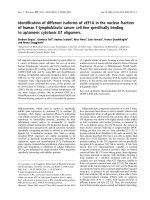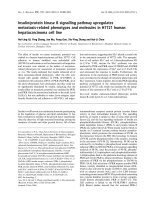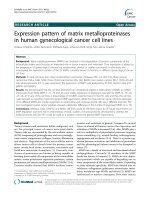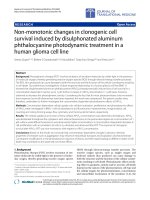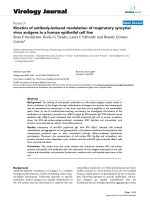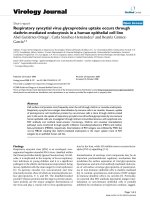Investigating the superoxide mediated survival pathway in the prostate cancer cell line LNCaP
Bạn đang xem bản rút gọn của tài liệu. Xem và tải ngay bản đầy đủ của tài liệu tại đây (3.69 MB, 199 trang )
i
INVESTIGATING THE SUPEROXIDE MEDIATED
SURVIVAL PATHWAY IN THE PROSTATE CANCER
CELL LINE LNCAP
GOH SHIJIE
B.Sci (Hons), NUS
A THESIS SUBMITTED
FOR THE DEGREE OF DOCTOR OF PHILOSOPHY
DEPARTMENT OF BIOCHEMISTRY
NATIONAL UNIVERSITY OF SINGAPORE
2012
ii
Acknowledgements
I would like to express my heartfelt gratitude to my supervisor and mentor,
A/P Marie-Véronique Clément, for her constant guidance, encouragement and advice
over the past nine years. It has been a long journey since the day I stepped into her
office, a hapless kid who knew nothing about science. Through her infectious
enthusiasm and patient guidance, I had developed a strong interest for research and
eventually decided to pursue this Ph.D. However, I could not have possibly completed
the work in this thesis without her constant encouragement and stimulating
discussions.
I also wish to thank my lab colleagues and friends for their help; be it in the
form of encouragement, advice, reagents or just a listening ear. I would like to
specifically thank Ms Teong Huey Fern, Dr Sharon Lim and Dr Michelle Chang Ker
Xing who took me under their wings and taught me many things despite their busy
schedules. I would also like to thank Mr Ping Yueh Shyang for the insightful
discussions and very enjoyable collaboration experience.
Last but not least, I would like to thank my dearest wife, Ms Adeline Tan, for
her support and belief in me. I really appreciate her kind understanding and
accommodation to my irregular lab working hours.
iii
Contents
Acknowledgements ii
Contents iii
Summary vi
List of Figures viii
Abbreviations x
CHAPTER 1: INTRODUCTION 1
1.1 CANCER BIOLOGY 1
1.2 SURVIVAL PATHWAYS 3
1.2.1 Growth factor signaling 3
1.2.2 PI3K-Akt signaling pathway 4
1.3 APOPTOSIS 6
1.3.1 The extrinsic and intrinsic pathway 7
1.3.2 MOMP and Bcl-2 family proteins 8
1.3.3 Regulation of BH3-only proteins 10
1.3.4 Models of Bax/Bak activation 13
1.4 Cancer cell metabolism and ph regulation 19
1.4.1 Cancer cell metabolism and glycolysis 19
1.4.2 Regulation of intracellular pH 20
1.5 ROS SIGNALING AND CANCER 22
1.5.1 Sources of intracellular ROS 22
1.5.2 ROS chemistry 23
1.5.3 Antioxidant defence 24
1.5.4 ROS as signaling components 25
1.6 PROSTATE CANCER 26
1.6.1 Prostate cancer and androgen receptor 27
1.6.2 Prostate cancer and PTEN 27
1.6.3 Oxidative stress in prostate cancer 28
1.6.4 The LNCaP model 29
1.7 AIM OF STUDY 32
CHAPTER 2: MATERIALS AND METHODS 33
iv
2.1 MATERIALS 33
2.1.1 Chemicals 33
2.1.2 Cell culture 34
2.1.3 Drug treatments 34
2.1.4 Antibodies 35
2.2 METHODS 36
2.2.1 Bax activation assay (saponin) 36
2.2.2 Bax activation assay (Leucoperm) 36
2.2.3 Caspase activity 37
2.2.4 Determination of intracellular pH, NHE activity and proton affinity 38
2.2.5 Bad phosphorylation ELISA assay 39
2.2.6 Kinase assay for Bad phosphorylation 40
2.2.7 Mitochondrial subcellular fractionation 41
2.2.8 SDS-PAGE and Western blotting 41
2.2.9 Gene knockdown by RNA interference 43
2.2.10 Measurement of intracellular H
2
O
2
level 44
2.2.11 Measurement of intracellular O
2
˙ˉ
level 44
2.2.12 Protein concentration determination 45
2.2.13 Propidium iodide staining for DNA fragmentation 45
2.2.14 RNA isolation and PCR 46
2.2.15 Statistical analysis 47
CHAPTER 3: RESULTS 48
3.1 MECHANISM OF LY294002 INDUCED APOPTOSIS 48
3.1.1 Bad dephosphorylation is essential for apoptosis 49
3.1.2 Bax is required for LY294002 induced apoptosis 53
3.1.3 Bak activation is required for apoptosis 58
3.1.4 Bcl-xL downregulation is required for apoptosis 62
3.2 SERUM PREVENTS LY294002 INDUCED APOPTOSIS 66
3.2.1 Serum promotes overexpression of Bcl-xL 71
3.2.2 Serum maintains Bad phosphorylation 73
3.2.3 Serum prevents Bax activation and translocation induced by LY294002 75
3.3 SUPEROXIDE REGULATION OF CELL SURVIVAL 79
v
3.3.1 Superoxide reduction results in loss of serum protection against LY294002
induced apoptosis 82
3.3.2 Serum and superoxide are distinct pathways 86
3.3.3 Superoxide promotes Bcl-xL expression 88
3.3.4 Superoxide maintains Bad phosphorylation 90
3.3.5 Superoxide prevents Bax activation 112
CHAPTER 4: DISCUSSION 148
4.1 SUPEROXIDE MAINTAINS PI3K-AKT INDEPENDENT SURVIVAL IN
LNCAP CELLS 148
4.1.1 EGF, R1881 and serum prevents LY294002 induced in LNCaP cells 148
4.1.2 Superoxide promotes survival independently from PI3K-Akt pathway 149
4.2 SUPEROXIDE MAINTENANCE OF BAD PHOSPHORYLATION IS PIM-1
MEDIATED 151
4.3 PIM-1 ACTIVITY CAN BE REGULATED BY SUPEROXIDE 153
4.3.1 Pim-1 half life and stability are increased in LNCaP cells 154
4.3.2 Redox regulation of Pim-1 activity 154
4.4 AKT SILENCING CAN DECREASE BAD SER75 PHOSPHORYLATION
156
4.5 NON-PH REGULATION FUNCTIONS OF NHE 157
4.6 MAINTENANCE OF NHE-2 FUNCTION IS ESSENTIAL FOR
PREVENTION OF BAX ACTIVATION 158
4.7 PIM-1 MEDIATED REGULATION OF NHE-2 159
4.8 SUPEROXIDE IS AN IMPORTANT MEDIATOR OF LNCAP SURVIVAL
160
4.9 POTENTIAL APPLICATIONS 161
4.10 CONCLUSION 163
References 165
Appendices 188
vi
Summary
Prostate cancer is the cancerous development of the prostate, and develops
over several years with little or no clinical symptoms. Hence, the detection and
diagnosis of prostate cancer usually occurs in the late metastatic stage, resulting in
poor prognosis. One of the most common mutations found in prostate cancer is the
inactivation mutation of PTEN. This leads to the constitutive activation of PI3K-Akt
signaling, conferring prostate cancer cells the ability to survive without external
mitogenic signals. However, current monotherapies targeting the PI3K-Akt survival
pathway remain ineffective, suggesting that there exists an alternate PI3K-Akt
independent survival pathway in prostate cancer cells. Increasingly, cancer
progression and aggressiveness have been found to correlate positively with mild but
higher than normal oxidative stress, which has been shown to enhance cancer cell
survivability and chemoresistance. More importantly, the investigation of redox
signaling in prostate cancer cells has identified the superoxide anion (O
2
˙ˉ
) as the key
reactive oxygen species in enhancing cell survival.
In this study, we provide evidence for the role of O
2
˙ˉ
in the activation of the
PI3K-Akt independent survival signaling in LNCaP, the most widely used in vitro
model for prostate cancer. LNCaP cells are able to survive and grow in the absence of
growth factors, but undergo apoptosis upon the shutting down of the PI3K-Akt
pathway by LY294002. However, EGF, R1881 and serum were shown to protect
LNCaP cells from LY294002 induced apoptosis, by maintaining Bad phosphorylation
and/or upregulating Bcl-xL expression. In this study, the roles of the Bcl-2 family
proteins were investigated and a set of parameters were defined. It was found that
vii
LNCaP survival was enhanced by maintaining Bad phosphorylation at serine 75,
upregulating Bcl-xL expression and preventing Bax/Bak translocation and activation.
Superoxide was shown in this study to be able to protect LNCaP cells against
LY294002 induced apoptosis. This was achieved by preventing Bax/Bak activation
via the defined parameters: maintaining Bad serine 75 phosphorylation, increasing
Bcl-xL expression and preventing Bax activation. We also show evidence that Pim-1
was the main effector in O
2
˙ˉ
signaling; maintaining Bad serine 75 phosphorylation.
This was consistent with reports of Pim-1 being a prognostic marker in prostate
cancer. Also, we have demonstrated for the first time that NHE-2 is required for Bax
activation in LNCaP cells, and that NHE-2 mediated Bax activation is prevented by
O
2
˙ˉ
signaling. In summary, this study has highlighted the crucial role of O
2
˙ˉ
in the
maintenance of the PI3K-Akt independent survival pathway in LNCaP cells.
viii
List of Figures
Figure 1: The hallmarks of cancer 2
Figure 2: The Bcl-2 protein family 9
Figure 3: BH3-only proteins can engage apoptosis via many different cellular
processes 11
Figure 4: Direct activation and displacement model 16
Figure 5: Bcl-xL dependent Bax retrotranslocation 18
Figure 6: Graphical representation of the NHE-1 protein 21
Figure 7: Production of ROS in cells 23
Figure 8: Mechanisms of survival enhancement in LNCaP 31
Figure 9: Role of Bad in LY294002 induced cell death 52
Figure 10: LY294002 treatment results in increased Bax translocation and activation
55
Figure 11: Bax is required in LY294002 induced cell death 57
Figure 12: Bax and Bak are involved in LY294002 induced apoptosis 61
Figure 13: Bcl-xL downregulation is required for LY294002 induced apoptosis 63
Figure 14: Mechanism of LY294002 induced apoptosis 65
Figure 15: Serum prevents LY294002 induced apoptosis 67
Figure 16: Serum rescues LY294002 induced cell death in LNCaP cells 70
Figure 17: Serum can increase Bcl-xL expression 72
Figure 18: Serum maintains Bad phosphorylation 74
Figure 19: Serum prevents Bax activation and translocation induced by LY294002 . 77
Figure 20: Serum prevents apoptosis in LNCaP cells 78
Figure 21: Decrease in superoxide can bypass serum protection 81
Figure 22: Superoxide reduction results in loss of serum protection against LY294002
induced apoptosis 85
Figure 23: Superoxide and serum are distinct pathways 87
Figure 24: Superoxide promotes Bcl-xL expression 89
Figure 25: Superoxide maintains Bad phosphorylation 93
Figure 26: Pim-1 can phosphorylate Bad at serine 75 in LNCaP 96
Figure 27: DPI, quercetagetin and removal of serum can lower phosphorylated Bad
levels 103
Figure 28: Dephosphorylation of Bad by quercetagetin bypasses serum protection . 107
Figure 29: Inhibition of Pim-1 by quercetagetin in the absence of Akt results in high
caspase 3 activity 111
Figure 30: DPI sensitizes LNCaP cells to cell death by causing Bax conformational
change 114
Figure 31: DPI induced intracellular acidification can be rescued by DDC 119
Figure 32: Inhibition of NHE by EiPa results in intracellular acidification and lowers
pH at which NHE begins proton extrusion 121
ix
Figure 33: Inhibition of NHE by EiPa removes protective effect of serum against
LY294002 induced cell death 124
Figure 34: EiPa treatment results in increased Bax activation 127
Figure 35: Inhibition of NHE-1 by cariporide results in intracellular acidification but
is unable to sensitize cells to LY294002 induced cell death 130
Figure 36: NHE isoform expression in LNCaP 132
Figure 37: Loss of NHEs 1 and 2 results in intracellular acidification 135
Figure 38: Loss of NHE-2 results in increased Bax activation 138
Figure 39: NHE-2 prevents Bax activation and intracellular acidification 140
Figure 40: Cytoplasmic C-terminus amino acid sequences of NHE isoforms expressed
in LNCaP 142
Figure 41: Pim-1 inhibition of quercetagetin has no effect on pH and NHE activity 143
Figure 42: NHE-2 plays a more important role in the regulation of pH in LNCaP than
NHE-1 146
Figure 43: Death circuitry in LNCaP 147
x
Abbreviations
BCECF-CM
2’,7’-bis(2-carboxyethyl)-5-(and-6)-carboxyfluorescein
BSA
Bovine serum albumin
CM-H
2
DCFDA
5-(and-6)-chloromethyl-2’,7’-dichlorofluorescin diacetate
DDC
Diethyldithiocarbamate
DMSO
Dimethylsulfoxide
DPI
Diphenylene iodonium
EiPa
Ethylisopropylamiloride
FBS
Fetal bovine serum
H
2
O
2
Hydrogen peroxide
NHE
Na
+
/H
+
exchanger
O
2
˙ˉ
Superoxide anion
PBS
PDK1
Phosphate buffered saline
Phosphoinositide-dependent kinase-1
pH
i
Intracellular pH
PI
PIP2
PIP3
Propidium iodide
Phosphatidylinositol (3,4)-bisphosphate
Phosphatidylinositol (3,4,5)-trisphosphate
PI3K
Phosphoinositide 3’-kinase
Q
Quercetagetin
RLU
Relative luminescence unit
ROS
Reactive oxygen species
RPMI
Roswell Park Memorial Institute
SOD
Superoxide dismutase
1
CHAPTER 1: INTRODUCTION
1.1 CANCER BIOLOGY
Cancer is a disease that involves uncontrolled cell growth, often resulting in
the invasion of adjacent tissues and impeding of function. These cells sometimes have
the ability to metastasize; having the ability to travel to other parts of the body,
invading different micro environments, often leading to multiple organ failure and
ultimately, death. According to the World Health Organization (WHO), cancer is the
leading cause of death in developed countries, and the second leading cause of death
in developing countries (Ferlay et al., 2010). Cancer is becoming more prevalent as
the world population grows and ages, especially in developing countries where people
are starting to lead sedentary lifestyles, eat processed food and smoke more. Thus, it
comes as no surprise that researchers are interested in this disease and resources are
used to understand and ultimately, find a cure for cancer.
The uncontrolled cell growth leading to cancer can originate from different
cell types, such as haemopoetic cells, epithelial cells or mesenchymal cells. There are
hundreds of different types of cancers; even different sub-types within specific
organs. One of the common features amongst the various types of cancers is the
dynamic changes that occur within the genome, bringing about mutations in key
cellular process such as proliferation, apoptosis and homeostasis. It is now known that
these mutations must affect at least six physiological capabilities of the cell in a
dynamic multistep manner in order for a normal cell to progress to a cancerous
phenotype (Hanahan and Weinberg, 2000). A normal cell has to acquire the ability to
multiply by becoming insensitive to anti-growth signals, developing self-sufficiency
in growth signaling, and breaking the reproduction limit. In addition, the cell must
2
also be able to evade apoptosis, sustain angiogenesis, and acquire the ability to invade
tissues and metastasize (Figure 1). In 2010, Hanahan proposed a further four
biological functions: deregulated metabolism, immune system evasion, unstable DNA
and inflammation were identified to be key contributors to the cancer phenotype
(Hanahan and Weinberg, 2011).
Figure 1: The hallmarks of cancer
The 10 hallmarks of cancer proposed by Hanahan. Each of the 10 hallmarks contributes to
cancer progression and is a result of mutations in normal cells. Also shown are the strategies
used to disrupt each of the capabilities required for tumour growth and progression. (Adapted
from Hanahan and Weinberg, 2011)
3
1.2 SURVIVAL PATHWAYS
1.2.1 Growth factor signaling
One of the most important physiological processes of the cell is the ability to
grow and proliferate. This is achieved by the activation of proliferation and survival
pathways via growth factor signaling. Growth factors consist of a large group of
proteins and steroids that have diverse functions such as regulating proliferation,
immune response, differentiation, survival and cell migration. Two capabilities
acquired by cancer cells in tumour progression involve growth factors; cells must be
able to proliferate in the absence of growth factors, and/or be self sufficient in the
generation of growth signals (Hanahan and Weinberg, 2000). Well known growth
factor signaling pathways include the mitogen-activated protein (MAP) kinase
pathways and the PI3K-Akt signaling pathway. MAP kinases respond to extracellular
signals such as mitogen and cytokine stimulation, osmotic stress and heat shock,
regulating a variety of cellular processes such as gene expression, proliferation,
survival and apoptosis (Pearson et al., 2001). Akt, also known as protein kinase B, is a
protein kinase that controls several important cellular functions such as transcription,
glucose metabolism, apoptosis, proliferation and cell migration (Downward, 1998).
The constitutive activation of Akt is a common feature of many cancers, playing a
major role in human malignancy (Nicholson and Anderson, 2002).
4
1.2.2 PI3K-Akt signaling pathway
Phosphatidylinositol-3-kinases (PI3K) contain a src homology 2 (SH2)
domain that enables their docking to phosphorylated tyrosine residues of activated
tyrosine kinase receptors (RTK) (Holt et al., 1994). When growth factors bind to their
RTKs, the phosphorylation of the tyrosine residues result in the recruitment of PI3K,
causing a conformation change that allows it to phosphorylate PIP2 to PIP3 at the
plasma membrane. PIP3 then acts as a lipid messenger, allowing proteins with the
pleckstrin homology (PH) domain to dock and activate downstream signals. Examples
of proteins containing PH domains that get recruited to the plasma membrane are Akt
and PDK1; their docking at the membrane brings them to close proximity. In addition,
the binding of Akt to PIP3 induces a conformational change which exposes its thr308
residue, allowing PDK1 to phosphorylate and activate it (Downward, 1998). Akt is
also phosphorylated at ser473 by mTOR/Rictor complex (Raught et al., 2001);
phosphorylation of Akt at both thr308 and ser473 is required for full activation.
Activated Akt achieves its role of perpetuating growth and survival by
transcriptional and non-transcriptional methods. Akt is responsible for the direct
inactivation of transcription factors such as the Forkhead family (FOXO) as well as
the indirect regulation of transcription factors such as p53 and NF-kB (Shaw and
Cantley, 2006). FOXO transcription factors responsible for the upregulation of genes
involved in apoptosis, once phosphorylated, are sequestered by 14-3-3 and remain in
the cytosol. Akt also phosphorylates and activates MDM2, which is an E3 ligase
responsible for targeting p53 for degradation (Song et al., 2005). This leads to
degradation of p53, an important transcription factor responsible for inducing growth
arrest and apoptosis. NF-κB, an important transcription factor controlling the
5
expression of pro-survival Bcl-xL and inhibitor of apoptosis proteins (IAPs), is
indirectly activated by Akt. The phosphorylation of IκB kinase (IKK) leads to its
activation and breakdown of IκBα, which is an inhibitor of NF-κB. This allows NF-
κB to translocate to the nucleus and activate the transcription of its target genes. Akt
can also prevent apoptosis by non-transcriptional mechanisms. Akt phosphorylates
Bad at ser99 (murine equivalent: 136), resulting in its binding and sequestration by
14-3-3 (Danial, 2008). Phosphorylated Bad is thus unable to translocate to the
mitochondria where it interferes with the protective effects of pro-survival Bcl-2
family proteins.
Active Akt signaling also induces growth and proliferation in the form of
increased glucose uptake, metabolism and biosynthesis. This is also achieved by
transcriptional and non-transcriptional methods. FOXO inactivation by Akt
phosphorylation, besides preventing apoptosis, also results in increased glycolysis.
Akt also phosphorylates key glycolytic enzymes such as hexokinase and
phosphofructokinase 2, hence increasing glycolysis and promoting ATP production
(Robey and Hay, 2009). Furthermore, Akt also phosphorylates and inhibits tuberous
sclerosis 2 (TCS2), the negative regulator of mTOR (Inoki et al., 2002). The
activation of mTOR consequently leads to an increase in lipid and protein
biosynthesis in response to nutrient availability, facilitating cell growth (Raught et al.,
2001).
Normal cells need mitogenic growth factor signals in order to activate the
PI3K-Akt pathway. The activation of Akt is kept in check by regulating the levels of
PIP3 present in the cell. This is achieved by phosphatases such as phosphatase and
tensin homolog deleted on chromosome 10 (PTEN), which dephosphorylates PIP3
6
back into PIP2, thus turning off the signal (Li et al., 1997; Maehama and Dixon,
1998). Aberrations to the regulation of the PI3K-Akt pathway are extremely common
in cancer development, where cancer cells acquire the ability to self-sustain growth
independent of growth signals (Luo et al., 2003). This is achieved by various
mechanisms such as amplification or constitutive activation of Akt signaling, as well
as the loss of function of PTEN. Indeed, PTEN is often deleted, inactivated or
downregulated in tumour cells (Simpson and Parsons, 2001; Sansal and Sellers,
2004). This highlights the importance of PTEN as a tumour suppressor; the loss of
PTEN seemingly more detrimental in conferring growth autonomy than amplification
or mutations that allow negative regulation bypass.
1.3 APOPTOSIS
The ability for a cell to undergo programmed cell death is a key physiological
capability for the body to remove unwanted or irreversibly damaged cells in a
controlled manner. This is an important function in preventing cancer cell
progression, as mutated cells are removed efficiently, thereby preventing tumour
growth. Apoptosis is thus a key component in cancer progression. The apoptotic
pathway can be broadly classified under the extrinsic and intrinsic pathway. The
extrinsic pathway involves the direct transduction of an external signal that activates
apoptosis. The intrinsic pathway is mediated by the mitochondria, which releases
cytochrome c when its outer membrane integrity is compromised by pro apoptotic
signaling. Both pathways lead to the activation of caspases which brings about the
apoptotic phenotype.
7
1.3.1 The extrinsic and intrinsic pathway
The extrinsic pathway is triggered by the aggregation of death receptors on the
cell surface. Death receptors such as CD95/Fas and tumour necrosis factor receptor
(TNFR) oligomerize upon binding with their respective ligands. The death receptor
oligomers recruit adaptor proteins via death domains (DD) present on both the
cytoplasmic tail of the receptors and the adaptors. The adaptors, which also contain a
death effector domain (DED), recruit procaspases that also possess the DED domain.
The close proximity of multiple procaspases results in their activation due to their low
innate proteolytic activity (Muzio et al., 1998; Boatright et al., 2003). The activated
procaspases then triggers the downstream caspase cascade evident in apoptosis by
activating executioner caspases like caspase 3.
Caspases are cysteine dependent proteases that cleave target proteins that
bring about the apoptotic phenotype (Creagh and Martin, 2001). The catalytic
function of caspases can be attributed to the presence of a cysteine residue in all
caspases. All caspases recognize a tetrapeptide motif and cleave after an aspartate
residue within this motif. The difference in these motifs confers substrate specificity,
which defines the roles of caspases in the apoptotic signaling cascade (Timmer and
Salvesen, 2007). The intrinsic and extrinsic pathways activate different forms of
initiator caspases (caspase 9 and 8 respectively), which activates executioner caspases
like caspase 3 via caspase-dependent proteolytic cleavage. These executioner caspases
then cleave and activate proteins like ICAD, PARP and nuclear lamins which bring
about the apoptosis phenotype.
The intrinsic pathway involves the mitochondrion, an important component in
the regulation of apoptosis (Green and Reed, 1998; Thornberry and Lazebnik, 1998).
8
Cytochrome c is released upon mitochondrial outer membrane permeabilization
(MOMP). The release of cytochrome c from the intermembrane space of the
mitochondria can be triggered by events such as DNA damage, oxidative stress,
absence of growth factors as well as oncogene expression (Alberts et al., 2008). The
translocation of cytochrome c from the mitochondria to the cytosol allows its binding
and association with apoptosis protease activating factor 1 (Apaf-1), ATP and
procaspases 9, resulting in the formation of apoptosomes. The close proximity and
favourable conformation leads to the activation of caspase 9 which brings about
apoptosis by activating downstream executioner caspases via proteolytic cleavage.
1.3.2 MOMP and Bcl-2 family proteins
The release of cytochrome c is controlled by the prevention of MOMP, which
is regulated by Bcl-2 family proteins known to play a major role in determining cell
fate (Chipuk and Green, 2008). Members of the Bcl-2 family possess either a pro-
survival or pro-apoptotic function (Youle and Strasser, 2008), and contain conserved
Bcl-2 homology (BH) regions that define which of the three categories they belong to.
The pro-survival family (Bcl-2, Bcl-xL, A1, Mcl-1) contain all four BH regions. The
presence of a highly hydrophobic transmembrane region at the C-terminal enables
members of the pro-survival family proteins to localize mostly on the membranes of
organelles. Pro-survival Bcl-2 family proteins share a common three-dimensional
structure which is important for their heterodimerization with other Bcl-2 family
members. They possess common BH1, BH2 and BH3 domains that form a
hydrophobic groove which is capable of binding to an exposed BH3 α-helix (Sattler et
9
al., 1997). Pro-survival Bcl-2 proteins function as antagonists of the pro-apoptotic
family by binding to and inhibiting their function.
The pro-apoptotic family can be further sub categorized into the multidomain
(BH1-3) effector group (Bax, Bak, Bok) and the BH3-only group (Bad, Bid, Bim,
Puma, Noxa, Bik, Bmf, Hrk/DP5, Beclin-1) (Hardwick and Youle, 2009; Shamas-Din
et al., 2011). MOMP is achieved when multidomain pro-apoptotic Bcl-2 proteins Bax
and Bak form a proteolipid pore on the outer mitochondrial membrane (Mikhailov et
al., 2003), while the main function of BH3-only proteins is to respond to cellular
stress signals and initiate the apoptotic signal. BH3-only proteins have different
subcellular localization as well as diverse mechanisms of activation, and have
preferential binding to the different members of the pro-survival Bcl-2 proteins as
well (Shamas-Din et al., 2011).
Figure 2: The Bcl-2 protein family
The Bcl-2 protein family consists of the anti-apoptotic Bcl-2 proteins, the pro-apoptotic
BH123 proteins and the BH3-only proteins. The α helices of the proteins are designated and
the bold lines define the BH domains. ‘TM’ marks the hydrophobic transmembrane domain.
Bcl-2 proteins play an important role in determining cell fate and survival, and can be
regulated by many overlapping pathways. (Adapted from Chipuk and Green, 2008.)
10
1.3.3 Regulation of BH3-only proteins
The number of BH3-only proteins identified has increased over the years and
there are now 9 known BH3-only proteins. In the direct activation model discussed
later, BH3-only proteins are further divided into two groups; the activators (Bim, Bid
and Puma) and sensitizers (Bad, Noxa, Bik, Bmf, Hrk/DP5, Beclin-1). The activators
directly activate Bax/Bak while the sensitizers play the more traditional role of
disrupting the sequestration of Bax/Bak by pro-survival Bcl-2 proteins. BH3-only
proteins are present in different cellular sublocalization; Bim can be found on
microtubules (O'Connor et al., 1998; Weber et al., 2007); Noxa on the mitochondria
(Oda et al., 2000; Ploner et al., 2008); Bad in the cytosol (Datta et al., 2000) and Bid
in the cytosol and nucleus (Li et al., 1998; Luo et al., 1998; Hu et al., 2003). BH3-
only proteins also respond to a variety of cellular stress (Figure 3) such as DNA
damage, cytokine deprivation, UV irradiation and death receptor activation (Willis
and Adams, 2005).
11
Figure 3: BH3-only proteins can engage apoptosis via many different cellular processes
A variety of cellular stresses are able to activate BH3-only proteins. Responding to different
cellular stresses, there can be more than one BH3-only protein activated. (Adapted from
Willis and Adams, 2005.)
A robust regulation of the BH3-only protein function prevents unwanted or
unintentional cell death. This is achieved by multiple restraining mechanisms such as
transcriptional control (Bim, Puma, Noxa) or post translational control such as
sequestration (Bad) or activation by truncation (Bid). For example, Puma is
upregulated upon the activation of p53 under cellular stress, providing the trigger for
MOMP (Nakano and Vousden, 2001). The inactive form of Bid is cleaved by caspase
8 in response to the Fas pathway, resulting in the active truncated tBid to activate Bax
and induce MOMP (Li et al., 1998; Luo et al., 1998). Several kinases have been
reported to phosphorylate Bad. Bad phosphorylation at serine 75 (murine equivalent:
serine 112) is attributed to kinases like RSK and Pim-1 (Aho et al., 2004; del Peso et
al., 1997; Fang et al., 1999; Harada et al., 1999; Scheid et al., 1999; She et al., 2002;
Yu et al., 2004; Zhang et al., 2004; Macdonald et al., 2006); while phosphorylation at
12
serine 99 and 118 (murine equivalent: serine 136 and 155) are phosphorylated by Akt
and PKA respectively (Bonni et al., 1999; Datta et al., 1997; Lizcano et al., 2000;
Harada et al., 2001). Phosphatases that dephosphorylate Bad include calcineurin
(Wang et al., 1999), PP2A (Chiang et al., 2001; Chiang et al., 2003) and PP1 (Ayllón
et al., 2000; Salomoni et al., 2000; Danial et al., 2003; Djouder et al., 2007).
Phosphorylated Bad is sequestered in the cytosol by 14-3-3, a chaperone that binds to
phosphoserine and phosphothreonine ligands. The dephosphorylation of Bad has
recently been proposed to be a multi-tiered process starting from the
dephosphorylation of serine 75, exposing serine 99 and 118 for further
dephosphorylation (Chiang et al., 2003). The phosphorylation status of Bad is
determined by the balance between the Bad kinases and phosphatases (Danial, 2008).
Upon dephosphorylation, Bad translocates to the mitochondria and binds to Bcl-xL,
disrupting its interaction with Bak and allowing MOMP (Datta et al., 2000).
The kinases, phosphatases, transcription factors and proteases involved in the
regulation of BH3-only proteins are usually also involved in the regulation of other
cellular processes such as metabolism (Danial, 2008; Bensaad et al., 2006), DNA
repair (Smith et al., 1995) or dephosphorylation in other signaling cascades (PP2A)
(Ory et al., 2003). The large number of BH3-only proteins each with differing
activation and response mechanisms confers versatility to the cell’s response to
cellular stress, thus creating a robust apoptotic program that can respond effectively
and correctly to irreversible cellular damage. However, there have been debates on
how BH3-only proteins activate Bax/Bak, with two major opposing models emerging.
13
1.3.4 Models of Bax/Bak activation
Bax and Bak are well known members of the multidomain pro-apoptotic Bcl-2
family and are essential for MOMP. The combined deletion of Bax and Bak leads to
cellular resistance to multiple apoptotic stimuli (Wei et al., 2001; Lindsten et al.,
2000). The third pro-apoptotic BH1-3 protein, Bok, is less well understood and is
associated with placental pathologies (Hsu et al., 1997; Ray et al., 2010). Bax can be
found in the cytosol as monomers whereas Bak is found on the surface of the outer
mitochondria membrane (Wei et al., 2001). To initiate MOMP, Bax and Bak must
oligomerize on the outer mitochondrial membrane to form pores (Mikhailov et al.,
2003). Both Bax and Bak must translocate to the mitochondria and undergo
conformational changes that would enable oligomerization leading to MOMP
(Antonsson et al., 2000; Annis et al., 2005). Translocation of Bax from the cytosol to
the mitochondria alone does not lead to MOMP; Bax translocation induced by
removing survival signals (Valentijn et al., 2003) did not induce MOMP. Thus,
translocation and activation of Bax and Bak by conformational changes are
requirements for successful MOMP. The C-terminus contains a tail anchor sequence
that allows the insertion of Bax and Bak to the outer mitochondrial membrane
(Lindsay et al., 2011). In fact, almost all of the multi-domain Bcl-2 proteins contain a
C-terminus anchor which defines their subcellular localization (Lindsay et al., 2011).
Under normal conditions, the predominantly cytosolic Bax contains a hydrophobic
groove on its surface that allows the C-terminus tail anchor to remain protected, thus
preventing mitochondria targeting (Suzuki et al., 2000). The activation of Bax and
Bak is achieved by the eversion of the BH3 domain which facilitates BH3-BH3
binding, leading to dimer formation (Dewson et al., 2008; Oh et al., 2010; Bleicken et
14
al., 2010). Recently, it has been proposed that Bax/Bak oligomerization can be
achieved by either the interaction of multiple dimers or by the formation of
asymmetrical heterodimers where an activated Bax/Bak protein is bound to the ‘rear
pocket’ of another activated Bax/Bak protein (Shamas-Din et al., 2011). The detection
of an activated Bax protein can be achieved by antibodies that recognize N-terminal
epitopes that are exposed upon activation (Hsu and Youle, 1998; Nechushtan et al.,
1999).
Rheostat model
The regulation of MOMP by Bcl-2 family proteins was initially thought to be
a straightforward process determined by the ratio of pro-survival and pro-apoptotic
protein expression (Oltvai et al., 1993; Yang et al., 1995). This hypothesis was
supported by evidence of increased apoptosis upon deletion of pro-survival Bcl-2
proteins and decreased apoptosis upon deletion of pro-apoptotic proteins (Veis et al.,
1993; Shindler et al., 1997; Motoyama et al., 1995). However, this model is
inadequate in accounting for the presence of high levels of Bax/Bak in healthy cells
and the differences in function of the many BH3-only proteins. Indeed, the
mechanism of BH3-only protein mediated Bax/Bak activation has become the focus
of research efforts, culminating in the advent of the two main competing models: the
displacement/indirect activation model and the direct activation model.
15
Displacement model
The displacement model proposes that multidomain pro-apoptotic proteins are
constitutively active and require continual neutralization by pro-survival Bcl-2 family
proteins. MOMP and apoptosis are triggered when BH3-only proteins displace
Bax/Bak from pro-survival Bcl-2 protein binding. The originally sequestered Bax and
Bak are thus liberated and are able to oligomerize and promote MOMP. In support of
this model, peptides derived from BH3-only proteins were found to have different
binding affinities to different pro-survival Bcl-2 members (Chen et al., 2005). These
peptides were able to bind to their respective pro-survival Bcl-2 proteins and displace
their interaction with Bax/Bak (Willis and Adams, 2005; Shimazu et al., 2007). In
addition, Bax and Bak could induce apoptosis in the absence of BH3-only proteins
like Bim or Bid, indicating their constitutively active nature (Willis et al., 2007).
However, the physiological relevance of these observations was questioned since
most of the work involved BH3 peptides and their interaction with
overexpressed/recombinant pro-survival proteins in solution or in a fixed supporting
matrix. Also, evidence of Bax binding to the BH3 stapled peptide of Bim (Gavathiotis
et al., 2008) suggests that Bax/Bak may be activated by BH3-only proteins.

